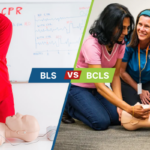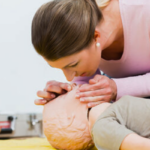
- Last Updated On: May 17, 2024
Quick Guide: First Aid Steps You Need to Know
Medical emergencies often occur right before us when we find an unresponsive adult, and where we have to size up the scene and prepare ourselves to give basic first aid steps to an injured person from a position that helps breathing in case of cardiac arrest or similar emergencies.
Other times, the lay responder must check for responsiveness when the patient’s breathing is concerned.
Knowing which first aid steps to take before the emergency medical services arrive, like washing your hands or wearing protective equipment like disposable gloves. It helps one save lives on the primary assessment of the situation.
Often first aid steps can save a life and help the patient come out of the life threatening conditions.
When you know which emergency medical care to provide, you, as the first responder, will not have to wait for medical services to arrive for a long time.
Instead, you can start to care for the patient and save their life on time.
It helps responders reduce tension surrounding the scene of the accident. They can also check for the responsiveness of the patient with utmost care and precision without panicking.
Administering immediate first aid care will enable you to help an injured victim before certified professionals arrive at the scene with protective equipment like disposable gloves and automated external defibrillator (AED) to take full control.
You may also save a life by administering the proper first aid steps. However, even after successful training and course completion in cardiopulmonary resuscitation, CPR, and first aid online classes, certified persons often need to remember the steps and how to administer them correctly.
In order to increase remembrance of priorities in a first aid situation, one is encouraged to take part in many training sessions and demos on how to administer first aid steps. It is also good to find out a guide on delivering basic first aid care and print it to carry wherever you go.
What to do before Administering First Aid?
Before administering the first aid steps, there are factors to consider first. It is advisable to take some time to assess the emergency scene and try to develop some answers to questions such as:
- What happened at the scene?
- How many people have been involved?
- Is the place safe to enter?
- What is your initial impression of the nature of the injured person?
- Is anyone available to help?
If the victim is awake and there is no evidence of severe bleeding after the initial check for responsiveness-
- Obtain the consent of the person by informing them of your name and plans to offer them care
- Obtain a first aid kit
- Use the appropriate self-defense mechanisms, i.e., put on disposable gloves
- Interview the victim and assess signs and symptoms that may be experienced; allergies and medication history should also be established
- Conduct a body check on the victim’s body for any signs of injury and put them in a position that helps breathing
- Provide basic assistance based on your assessment of the situation
If the victim appears unresponsive:
Shout the person’s name out to get their attention. If there is no response, tap the person’s shoulders while calling out their name. Check the person’s breathing for not more than 10 seconds.
If the victim is breathing:
Loosen any tight clothing on the patient’s body, including belts and ties. Call emergency numbers and request help. Conduct a body check on the patient. Put the patient into a recovery position by rolling him to the side.
If the patient is not breathing:
Call emergency numbers, inform them of the situation and the location of the incident, and ask for professional help. Now put the victim into a position that helps them in breathing properly. This way, they can receive full air circulation. Begin administering CPR immediately. Start with chest compressions as you observe the victim’s reaction. Proceed with rescue breaths to ensure the person gains breathing. If there is another person around, call for their help in administering CPR. It is advisable to stop administering the CPR if the area becomes unsafe or if you can’t continue because of exhaustion.
Other notes on first aid steps:
Do not ever panic when someone’s life is in danger in front of you. It could be due to bleeding, choking, or allergic reactions. With the proper knowledge, you can save their life in a snap. However, it would help if you took control of your emotional response to the situation. After that, you need to process what is happening, who is hurt, and how to save their life.
Also, remember that you can easily call 911 when you are too scared. However, keep the emergency connected on the phone call. Most frequently, they guide you with the best first aid steps to help the patient and restore their recovery position on time.
Conclusion:
Taking CPR and first aid online classes equips you with knowledge of how to save a life during an emergency by administering first aid.






